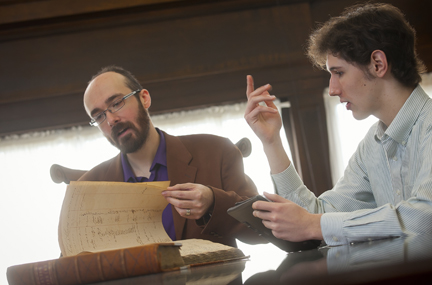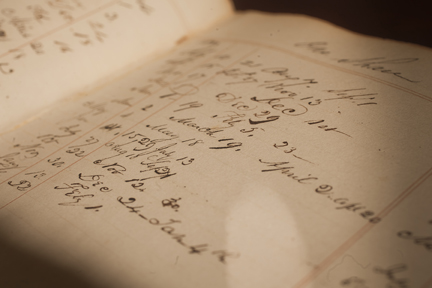Until a year ago, the emerging research field of the history of reading was largely circumstantial, based on diaries or sales figures. A public database launched last March and later reported by Anne Trubek in the New York Times article “What Muncie Read” set the stage for authoritative records of American reading.
The Muncie, Ind., database, based on the library ledgers of Muncie Public Library from 1891 to 1902, was compiled by Frank Felsenstein, a historian at Ball State University, and colleague James Connolly.
At Lafayette, a similar database is under construction by Chris Phillips, assistant professor of English, and research assistant Gavin Jones ’14. The only project dating from the early 1800s, it is valuable not only for what it reveals about the reading habits of the citizens of Easton 200 years ago, but also for the sociological and anthropological revelations.

Professor Chris Phillips (left) and Gavin Jones ’14 examine early circulation records at Easton Public Library.
When Phillips discovered that the original circulation records of Easton Library Company still existed, he set out to capture the invaluable information and to seek the answer to what Eastonians read at that time. The company, formed in 1811, was the precursor to Easton Area Public Library.
Not only is Phillips’ project on the cutting edge—among only four others in progress around the country–it is more rare in the fact that the Easton records begin in 1811. In a Nov. 17 Slate article, John Plotz writes that “precious little data from libraries before 1860 exists.”
During a recent presentation at Easton Library held as part of the celebration of its 200-year anniversary, Phillips described his research and some of his findings.

Easton Library Company circulation volume from 1820
By transcribing the handwritten information from the bound volumes of circulation records from 1811-1862, Phillips and Jones are creating a database of information about the library’s use over a 50-year period. They are working with Barbara Wiemann, senior coordinator for local history, and Jennifer Stocker, director, of Easton Area Public Library. Others at Lafayette involved include Diane Shaw, director of special collections and College archivist; Eric Luhrs, digital librarian; and Paul Miller, visual digital production manager.
“The concept of a free library where local citizens could check out books at no cost did not arise until after the Civil War,” says Phillips. “In Easton, a group of citizens decided to form the library company to loan books among each other; they sold 100 shares to those who wanted to borrow books.”
The price to join was $4, and the annual fee was $2. The circulation records show that members were allowed to let close relatives borrow under their “membership.” Of the original 100 members, three were women.
Within four years the company could afford to pay a librarian $1.50 a month, and to begin construction of a building on land donated by Samuel Sitgreaves. The red brick building from that time still stands at the corner of North Second and Church streets.
In 1860, the collection had grown to 4,000 volumes. By comparison, the library at Lafayette College, where classes began in 1832, had only 1,000 volumes, most of which belonged to literary societies or faculty members. Phillips says the largest category was fiction, accounting for 40 percent, followed by periodicals, then history, travels, belles-letters, biography, and science/medicine.
Transcription of the records will continue through 2012 with launch of the database sometime afterwards. The database will provide a way to analyze who was reading what during that time period as well as information about social networks.
“What’s so great is that we are not locked into one course of action,” says Jones. “As new information comes up, Dr. Phillips and I can decide to pursue it or not. It’s a project of continual discovery, and that’s what makes it exciting.”
Phillips described some of the more interesting books in the collection:
- Methodus Balsamandi Corpora Humana, 1679, by Gabriel Clauder, a book in Latin about how to embalm bodies
- The Life of George Washington, 1804-1807, five volumes, written by John Marshall, long-standing Supreme Court Justice
- Sketches in India by William Huggins, 1824, few volumes of which exist
- Mahlerische skizzen von Teutschland, 1759, by Christian August Gunther and Friedrich Christian Schlenkert, a travel book about Germany with engravings
Jones got involved in the project because of his interest in history. “I’ve been working on it since I came to Lafayette,” he says. “It gives me a way to focus my energy and interest in English and history. I’ve learned more and more about the history of Easton and find it interesting to see so many different names under one shareholder’s account.”
With a strong interest in chemistry as well, Jones has been taking courses in that area and others. “A lot of my friends seem to know exactly what they want to do or be, but I am interested in so many things; I’m still exploring,” he says. He chose neuroscience as his major because it allows a “balance of courses between science and the humanities.”


1 Comment
Comments are closed.